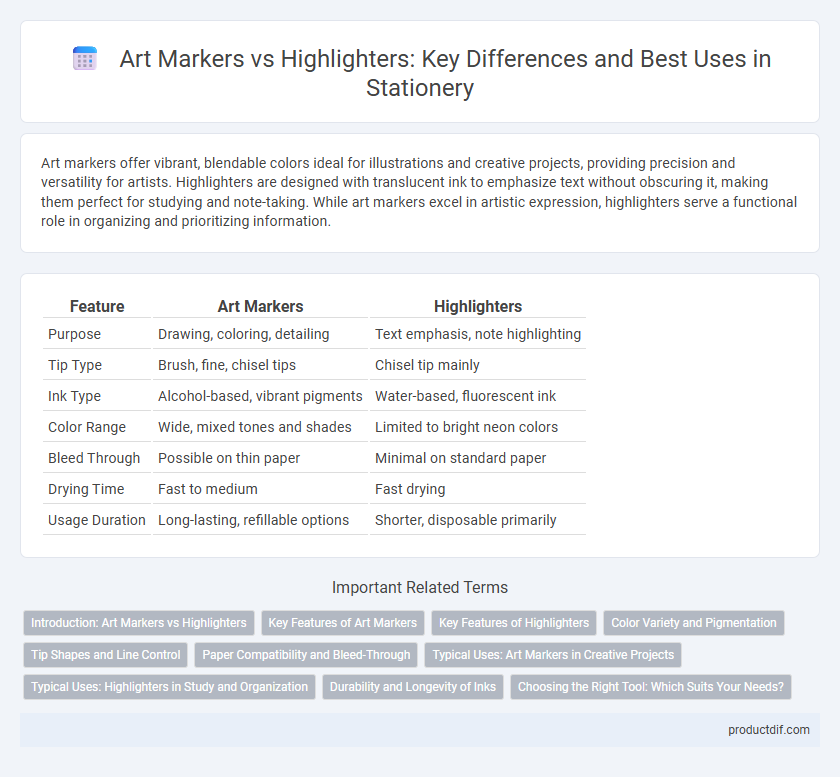Art markers offer vibrant, blendable colors ideal for illustrations and creative projects, providing precision and versatility for artists. Highlighters are designed with translucent ink to emphasize text without obscuring it, making them perfect for studying and note-taking. While art markers excel in artistic expression, highlighters serve a functional role in organizing and prioritizing information.
Table of Comparison
| Feature | Art Markers | Highlighters |
|---|---|---|
| Purpose | Drawing, coloring, detailing | Text emphasis, note highlighting |
| Tip Type | Brush, fine, chisel tips | Chisel tip mainly |
| Ink Type | Alcohol-based, vibrant pigments | Water-based, fluorescent ink |
| Color Range | Wide, mixed tones and shades | Limited to bright neon colors |
| Bleed Through | Possible on thin paper | Minimal on standard paper |
| Drying Time | Fast to medium | Fast drying |
| Usage Duration | Long-lasting, refillable options | Shorter, disposable primarily |
Introduction: Art Markers vs Highlighters
Art markers feature pigment-rich, blendable ink designed for illustration and detailed artwork, offering a broad range of vibrant colors and varying tip shapes. Highlighters use translucent, neon-colored ink specifically formulated to emphasize text without obscuring it, typically offering chisel tips for precise underlining. Both tools serve distinct purposes in creative and academic settings, with art markers excelling in artistic expression and highlighters optimizing readability and organization.
Key Features of Art Markers
Art markers feature high-quality, blendable ink with vibrant pigments, ideal for detailed artwork and professional illustrations. They often have dual tips, such as a fine tip for precision and a brush tip for smooth gradients and calligraphy. These markers use alcohol-based or water-based formulas that ensure quick drying, fade resistance, and minimal bleeding on various paper types.
Key Features of Highlighters
Highlighters feature fluorescent ink designed to emphasize text without obscuring underlying content, making them essential for studying and note-taking. They typically have chisel tips that allow for broad or fine highlighting, enhancing versatility and precision. The ink is often quick-drying and smudge-resistant, ensuring clean and clear markings on various paper types.
Color Variety and Pigmentation
Art markers offer a wider range of vibrant color varieties and richer pigmentation compared to highlighters, which typically feature translucent, limited hues designed for emphasis. The saturated pigments in art markers enable smooth blending and detailed artwork, while highlighters prioritize bright, neon tones for enhancing text visibility. Choosing between them depends on whether the need is for artistic expression with deep color or functional marking with fluorescent brightness.
Tip Shapes and Line Control
Art markers typically feature a variety of tip shapes such as brush, chisel, and fine tips, allowing for versatile line control ideal for detailed artwork and broad strokes. Highlighters predominantly have chisel tips designed to create broad, consistent lines for emphasizing text quickly. The varied tip shapes of art markers enable precision and fluidity, whereas highlighters prioritize uniformity and speed in mark-making.
Paper Compatibility and Bleed-Through
Art markers typically feature alcohol-based ink that penetrates paper fibers deeply, offering vibrant colors but posing a higher risk of bleed-through on thin or low-quality paper. Highlighters use water-based or fluorescent ink designed to mark text clearly without bleeding excessively, making them ideal for standard office or school paper. Selecting the right marker depends on the paper's weight and coating; heavyweight or specially coated paper reduces bleed-through for art markers, while highlighters remain effective on typical copy and notebook paper.
Typical Uses: Art Markers in Creative Projects
Art markers excel in creative projects due to their vibrant pigments and blendable ink, making them ideal for illustrations, graphic design, and detailed coloring. Their versatility allows artists to achieve smooth gradients and precise lines on various paper types, enhancing artistic expression. Unlike highlighters, which are primarily designed for emphasizing text, art markers provide rich color depth suited for professional and hobbyist artwork.
Typical Uses: Highlighters in Study and Organization
Highlighters are essential for study and organization due to their translucent, bright colors that emphasize key text without obscuring underlying information. They enhance note-taking efficiency by drawing attention to critical concepts, making review sessions more effective for exams and presentations. Commonly used in academic and professional settings, highlighters help categorize and prioritize information through color-coded systems.
Durability and Longevity of Inks
Art markers use high-quality, fade-resistant ink designed for long-lasting vibrancy on various surfaces, ensuring durability for artistic projects. Highlighters typically contain fluorescent, water-based ink that fades faster over time and with excessive exposure to light. The longevity of art marker inks surpasses that of highlighter inks, making them more reliable for archival and professional uses.
Choosing the Right Tool: Which Suits Your Needs?
Art markers offer vibrant, blendable colors ideal for detailed illustrations and creative projects, while highlighters are designed with translucent ink to emphasize text without obscuring it. Selecting the right tool depends on your purpose: use art markers for sketching, coloring, and artistic expression, and highlighters for note-taking and organizing important information. Consider ink type, tip shape, and color intensity to match your specific stationery needs.
Art markers vs Highlighters Infographic

 productdif.com
productdif.com